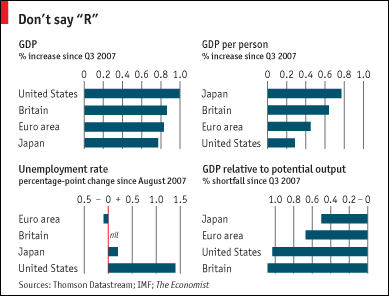News Home
Home - Index - News - Krisen 1992 - EMU - Economics - Cataclysm - Wall Street Bubbles - US Dollar - Houseprices
The economists’ rule that a recession is defined by two consecutive quarters of falling GDP is silly.
The standard definition of recession needs rethinking.
To the average person, a large rise in unemployment means a recession.
By contrast, the economists’ rule that a recession is defined by two consecutive quarters of falling GDP is silly.
The Economist print Sep 11th 2008
The chart looks at several different ways to judge the severity of the economic slowdown since the start of the credit crunch in August 2007.

As the old joke goes: when your neighbour loses his job, it is called an economic slowdown. When you lose your job, it is a recession. But when an economist loses his job, it becomes a depression. Economists who ignore the recent rise in unemployment deserve to lose their jobs.
Ett enkel, mekaniskt, men ändå lärorikt sätt att spalta upp arbetslöshetproblemet bygger på följande samband:
Tillväxt i BNP minus ökning i produktivitet minus ökning i arbetsstyrkan = förändring i arbetslösheten.
Om BNP stiger med 3,2 procent och produktiviteten samtidigt ökar med 2,2 procent och antalet personer i arbetskraften ökar med 0,5 procent minskar arbetslösheten med 0,5 procentenheter.
"Sambandet är just ett samband. Så måste det helt enkelt vara."
Ur Marian Radetzkis bok "Klarspråk om arbetslöshet" (SNS Förlag, 1996) sid 34 ff och 81 ff, utdrag.)
Conclusion by Rolf Englund:
Recession 2.0 should go like this:
A recession occurs when the growth of the GDP is smaller than the rise in productivity
More by Rolf Englund in english